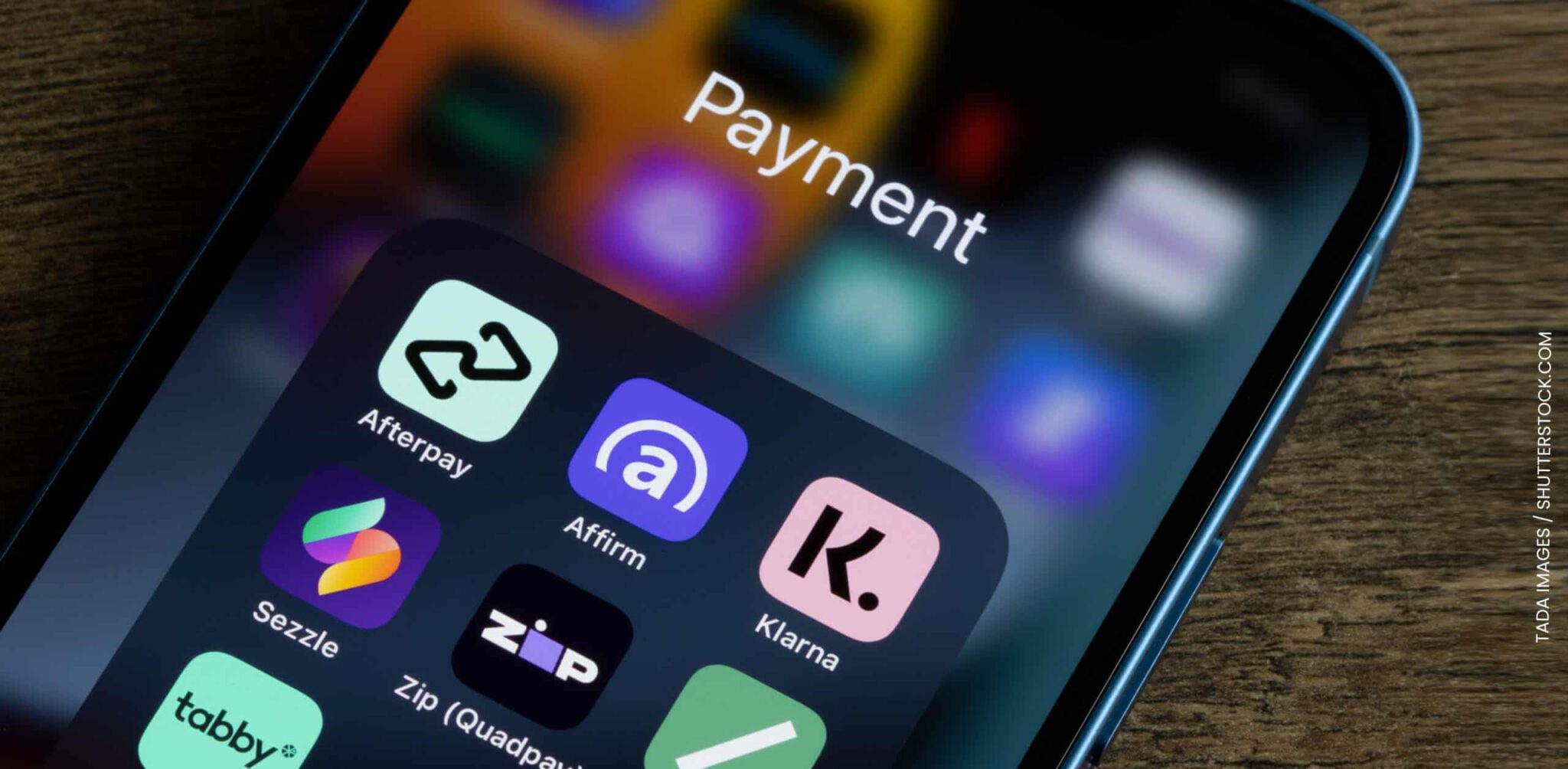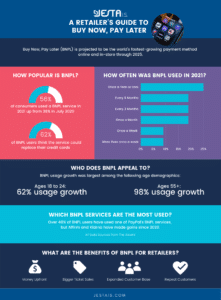by Camille Chin | April 11, 2022
Today, shoppers have several ways of making a purchase, but merchants can expect Buy Now, Pay Later (BNPL) to lead the way for years to come, particularly with the Millennial and Gen Z demographic.
According to the 2022 Global Payments Report released by FIS:
• BNPL accounted for 2.9% (US$157 billion) of all global e-commerce transaction value in 2021; it’s expected to account for 5.3% (US$438 billion) by 2025
•BNPL is the fastest growing payment method at the Point of Sale (POS) globally
• Digital wallets remain popular accounting for 48.6% of global e-commerce transaction value in 2021, while credit cards and cash continue to lose share
BNPL Basics
BNPL, also called Point-of-Sale loans, is a type of short-term financing that allows shoppers to buy items online or in store and pay for them via installments. Payments are often via four interest-free installments. BNPL differs from Layaways. Layaways allow shoppers to pay slowly, but they don’t receive their items until all the payments are made.
Affirm, Klarna, PayBright, PayPal and Zip are some BNPL lenders. In a 2022 survey by PYMNTS, 70 percent of current BNPL users expressed interest in bank-issued BNPL plans. Interestingly, the interest is across all consumer demographics; 47 percent of consumers who earn more than $100,000 annually are keen on plans from their financial institution.
BNPL providers often only require a soft credit check for shoppers to qualify — with some actually requiring nothing at all. Credit cards, in contrast, require hard credit reports. BNPL providers tend to charge merchants higher fees than credit card companies, but there are benefits.
The Benefits of BNPL for Retailers
Money Upfront
When customers use BNPL, the BNPL service provider pays the merchant the full price for the purchased product and bears the burden of collecting the installments. The BNPL provider also assumes the risks of fraud and chargebacks.
Bigger-Ticket Sales
Many shoppers abandon their carts when they consist of higher priced items, particularly if they’re undecided. BNPL is popular with items hovering around US$200. BNPL plans encourage higher-priced purchases because shoppers can try items before having to pay the full amount.
An RBC Capital Markets report estimates that BNPL plans increase retail conversion rates 20 to 30 percent and lifts the average ticket size between 30 and 50 percent.
Expanded/Repeat Customers
BNPL makes it possible for consumers to shop with merchants they perhaps couldn’t afford to shop with previously. What’s more, according to a recent PayPal study, 28 percent of consumers aged 18-39 are more likely to shop at a merchant again if it offers BNPL payment options.
The Risks For Consumers
Most BNPL providers don’t charge interest rates, but some charge transaction and late fees. Zip, for example, charges a US$4 transaction fee for every purchase (essentially US$1 per installment) and a US$7 late fee for each overdue installment (the amount varies by statute/state).
When it comes to returns, customers want immediate refunds, but purchases made through BNPL require additional steps for reimbursements. Customers have to go through merchants first before refunds can be issued by BNPL providers. Some plans require customers to continue making their installments even after they’ve returned what they bought. Also, when it comes to disputes between customers and merchants, BNPL providers tend to take a hands-off approach.
The BNPL industry hasn’t existed that long, but critics are sounding the alarm that BNPL plans encourage people to borrow more than they can afford. Research from British economists published in February 2022 examined the transactions of one million credit cards held by U.K. consumers and discovered that 20 percent were used to cover BNPL installment loans last year.
In December 2021, the US Consumer Financial Protection Bureau (CFPB) ordered a handful of BNPL providers to provide details on their business practices, citing concerns about debt.
“If a consumer has multiple purchases on multiple schedules with multiple companies, it may be hard to keep track of when payments are scheduled,” the CFPB said in a press release. “When there is not enough money in a consumer’s bank account, this can potentially result in charges by both the consumer’s bank and the BNPL provider.”
The Risks For Retailers
Fraud is a concern for retailers. Fraudsters often have partial info about a consumer (a full name, for example) and they phish for the last piece they need (like a telephone number). Since activating a BNPL plan only requires a soft pull on a consumer’s credit history, verifying identities is a challenge. Plus, so many users are new to the credit pool.
What’s more, BNPL is an elongated transaction so there are multiple opportunities for fraud. Merchandise is received before it’s fully paid off and if a customer isn’t making additional payments for several weeks, a merchant isn’t even going to know whether it’s a fraudulent transaction until weeks later when additional installments aren’t received.
BNPL solutions are attractive to both merchants and consumers, and its inherent simplicity is driving its popularity, particularly with the Millennial and Gen Z demographic. But with risks ranging from fees to fraud, consumers, BNPL providers and merchants must proceed wisely. Watch for new BNPL regulations soon and an evolution of payment products in the next few years.
Check out the BNPL infographic here.
For more great insights on BNPL, check out Episode 10 of Jesta’s podcast: Buy Now, Pay Later: The Risks & Rewards for Retailers & Consumers. Our guest speaker is fintech expert Steven Mu, Director of Partnerships at Citcon. Listen here.

